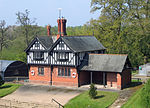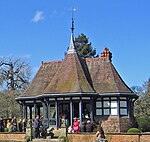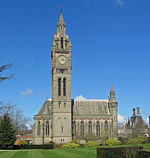Aldford
Cheshire West and ChesterFormer civil parishes in CheshireUse British English from February 2021Villages in Cheshire

Aldford is a village and former civil parish, now in the parish of Aldford and Saighton, in the Cheshire West and Chester district, in the ceremonial county of Cheshire, England. (grid reference SJ420592). The village is approximately 6.5 miles (10.5 km) to the south of Chester, on the east bank of the River Dee. The Aldford Brook joins the Dee just north of the village. In the 2001 census, the population of the parish was 213. The population of the civil parish was recorded as 272 in the 2011 census.
Excerpt from the Wikipedia article Aldford (License: CC BY-SA 3.0, Authors, Images).Aldford
Chester Road,
Geographical coordinates (GPS) Address Nearby Places Show on map
Geographical coordinates (GPS)
| Latitude | Longitude |
|---|---|
| N 53.126 ° | E -2.866 ° |
Address
Chester Road
Chester Road
CH3 6HJ , Aldford and Saighton
England, United Kingdom
Open on Google Maps










